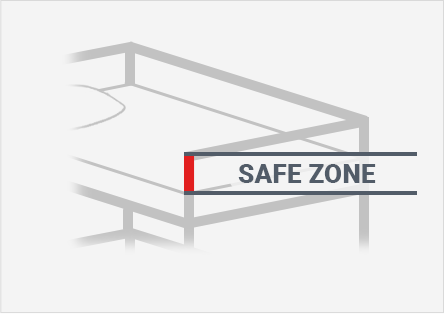Mattress Safe & Comfort zones Guide
Mattress models ranging in thickness from 10 to 14 inches thick are the most acceptable to mattress buyers. As shown above traditional coil spring mattresses can range from about 5 inches to well over 20 inches in thickness.
So, you found your perfect Bunk Bed or Loft Bed – Congratulations! Now the search for that perfect Bunk Bed Mattress begins... and it’s not as straightforward as you might think! What should you consider when picking a mattress that works well for an elevated bed such as a Loft Bed or a Bunk Bed? Do the same considerations matter like picking a regular mattress? How do you find the right quality, features and comfort?
1. safety top bunk
From top of mattress to top of guard rail is safety zone
Consider a Low Profile Mattresses 5” to maximum 8” tall to maximize Safety Rail Height for the top bunk. Remember, the thicker your mattress is, the higher up you sleep – taking away valuable inches from your top bunk’s safety rail. Especially if you have young children in the home we highly recommend a good quality Low Profile Mattress for your bunk bed or loft bed.
2. space for lower bunk
Space between top of mattress to bottom of upper bunk
Under-bed height is very important for the bottom bunk – so don’t go too plush there either! The thicker the mattress on the bottom bunk bed, the less headroom you will have. And while you may not be too concerned about this if you have little kids, remember that reading stories, tucking in and kissing good-night is usually a grown up’s job and they certainly appreciate being able to sit up straight even in the lower bunk bed. Again, a low profile mattress is a great choice for bottom bunks for this very reason – depending on what quality you decide on you don’t have to give up on comfort even on a low profile bunk bed mattress.
3. Upper Comfort Zone
Space between from top of upper mattress to ceiling
Great quality foam beats springs for top bunks, especially if you have kids sleeping up high. A bouncy mattress encourages kids to... well... bounce! In contrast, a foam mattress helps your body sink into it and creates a less “springy” surface. If you are thinking about mattresses for bunk beds or Loft beds – i.e. elevated sleeping surfaces – these details matter! We all know that kids will play in and on these beds, so the more we can contribute to a safe environment, the better. So we usually recommend a good quality memory foam or even latex mattress for any elevated bed, and we suggest leaving the spring mattress for the bottom bunk.
4. in case of loft bed there is important clearance zone
Space between from ground to bottom or upper rail
Floor to the bottom edges of the Mattress Rails (two wide pieces that run the length of the loft bed). Standard is 56 1/4" for Douglas Fir loft beds, or 56" for Red Oak Plywood loft beds. This is usually only significant if you want to walk clearly under the loft bed, without ducking at all, but let us know if you have a different situation where this is relevant. For use as a desk area, it`s recommended that there be at least 52 inches of clear space between the bottom of the loft platform and the floor. This allows average users to sit comfortably in a chair.




